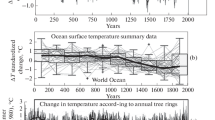Abstract
This paper analyzes climate changes since the end of the last glaciations 19–20 thousand years ago, including the modern warm interglacial Holocene age, which started about 11.5 thousand years ago. The connection between the impact of the orbital effect and solar activity on the Earth’s climate is studied. This is important for estimation of the duration of the modern interglacial period. It is shown that there is significant inconsistency between temperature variations in Holocene, which is deduced from the large amount of recently obtained indirect data and the temperatures reproduced in the climate models. The trends of climate cooling in the Holocene on the whole and during the last 2000 years are investigated.
Similar content being viewed by others
References
Alder, J.R. and Hostetler, S.W., Global climate simulations at 3000-year intervals for the last 21 000 years with the GENMOM coupled atmosphere–ocean model, Clim. Past, 2015, vol. 11, no. 3, pp. 449–471.
Berger, A. and Loutre, M.F., Insolation values for the climate of the last 10 million years, Quat. Sci. Rev., 1991, vol. 10, pp. 297–317.
Byalko, A.B., Paleoclimate: Supplements to the Milankovitch theory, Priroda (Moscow, Russ. Fed.), 2009, no. 12, pp. 18–28.
Clark, P.U., Shakun, J.D., Paul, A., Baker, P.A., et al., Global climate evolution during the last deglaciation, Proc. Natl. Acad. Sci. U. S. A., 2012, vol. 109, pp. E1134–E1142.
Cuffey, K.M. and Clow, G.D., Temperature, accumulation, and ice sheet elevation in central Greenland through the last deglacial transition, J. Geophys. Res., 1997, vol. 102, pp. 26383–26396.
Dergachev, V.A., Manifestation of the long-term solar cyclicity in climate archives over 10 millennia, in Proceedings of the IAU Symposium No. 223, 2004, International Astronomical Union, 2004. doi 10.1017/S1743921304007379
Dergachev, V.A., Solar activity, cosmic rays, and Earth temperature reconstructions for the past two millennia. Part 1. Analysis of temperature reconstructions, Geomagn. Aeron. (Engl. Transl.), 2015a, vol. 55, no. 1, pp. 1–12.
Dergachev, V.A., Solar activity, cosmic rays, and Earth temperature reconstructions for the past two millennia. Part 2. Analysis of the relation between the global temperature variations and natural processes, Geomagn. Aeron. (Engl. Transl.), 2015b, vol. 55, no. 2, pp. 139–151.
Dergachev, V.A. and Raspopov, O.M., Long-term solar activity as a controlling factor for global warming in the 20th century, Geomagn. Aeron. (Engl. Transl.), 2009, vol. 49, no. 8, pp. 1271–1274.
Dergachev, V.A. and Raspopov, O.M., Problem of the length of the current interglacial, Geomagn. Aeron. (Engl. Transl.), 2013, vol. 53, no. 7, pp. 876–881.
Esper, J., Frank, D.C., Timonen, M., et al., Orbital forcing of tree-ring data, Nature Clim. Change, 2012, vol. 2, pp. 862–866.
Esper, J., Düthorn, E., Krusic, P.J., et al., Northern European summer temperature variations over the common era from integrated tree-ring density records, J. Quat. Sci., 2014, vol. 29, no. 5, pp. 487–494.
Heinemann, M., Timmermann, A., Elison Timm, O., et al., Deglacial ice sheet meltdown: Orbital pacemaking and CO2 effects, Clim. Past, 2014, vol. 10, pp. 1567–1579.
IPCC Climate Change 2007: The Physical Science Basis, Solomon, S., Qin, D., Manning, M., Eds., Cambridge: Cambridge University Press, 2007.
Israde-Alcántara, I., Bischoff, J.L., Dominguez-Vázquez, G., et al., Evidence from central Mexico supporting the Younger Dryas extraterrestrial impact hypothesis, Proc. Natl. Acad. Sci. U. S. A., 2012, vol. 109, no. 13, pp. 4723–4724.
Kennett, D.J., Kennett, J.P., West, A., et al., Nanodiamonds in the Younger Dryas boundary sediment layer, Science, 2009, vol. 323, no. 5910, p. 94.
Kokorin, A.O., Izmenenie klimata: obzor Pyatogo otsenochnogo doklada MGEIK (Climate Change: Overview of the IPCC Fifth Assessment Report), Moscow: World Wildlife Fund, 2014.
Kotlyakov, V.M., On causes and effects of current climate changes, Soln.-Zemnaya Fiz., 2012, no. 21, pp. 110–114.
Liu, Z., Zhu, J., Rosenthal, Y., et al., The Holocene temperature conundrum, Proc. Natl. Acad. Sci. U. S. A., 2014, vol. 111, no. 34, pp. E3501–E3505.
Lockwood, M., Solar influence on global and regional climates, Surv. Geophys., 2012, vol. 33, nos. 3–4, pp. 503–534.
Marcott, S.A., Shakun, J.D., Clark, P.U., and Mix, A.C., A reconstruction of regional and global temperature for the past 11,300 years, Science, 2013, vol. 339, pp. 1198–1201.
McManus, J.F., Francois, R., Gherardi, J.M., Keigwin, L.D., and Brown-Leger, S., Collapse and rapid resumption of Atlantic meridional circulation linked to deglacial climate changes, Nature, 2004, vol. 428, no. 6985, pp. 834–837.
Nicola, J., Evidence found for planet-cooling asteroid 12,900 years ago, Nature, 2013. doi 10.1038/nature.2013.13661
Petit, J.P., Jouzel, J., Raynaud, D., et al., Climate and atmospheric history of the past 420,000 years from the Vostok ice core, Antarctica, Nature, 1999, vol. 399, pp. 429–436.
Rapp, D., Ice Ages and Interglacials: Measurements, Interpretation and Models, New York: Springer, 2009.
Raspopov, O.M., Dergachev, V.A., Zaitseva, G.I., and Ogurtsov, M.G., Deep solar activity minima, sharp climate changes, and their impact on ancient civilizations, Geomagn. Aeron. (Engl. Transl.), 2013, vol. 53, no. 8, pp. 917–921.
Schmitt, J., Schneider, R., Elsig, J., et al., Carbon isotope constraints on the deglacial CO2 rise from ice cores, Science, 2012, vol. 336, pp. 711–714.
Seregin, S.Ya., Natural sources of the current fluctuating warming of the Earth’s climate, Ekol. Zhizn, 2011, no. 11, pp. 46–49.
Shakun, J.D., Peter, U., Clark, P.U., He, P., et al., Global warming preceded by increasing carbon dioxide concentrations during the last deglaciation, Nature, 2012, vol. 484, pp. 49–54.
Wu, Y., Sharma, M., LeCompte, M.A., et al., Origin and provenance of spherules and magnetic grains at the Younger Dryas boundary, Proc. Natl. Acad. Sci. U. S. A., 2013, vol. 110, pp. 3557–3566. doi 10.1073/pnas.1304059110
Author information
Authors and Affiliations
Corresponding author
Rights and permissions
About this article
Cite this article
Dergachev, V.A. The impact of solar radiation and solar activity on climate variability after the end of the last glaciation. Geomagn. Aeron. 56, 908–913 (2016). https://doi.org/10.1134/S0016793216070033
Received:
Accepted:
Published:
Issue Date:
DOI: https://doi.org/10.1134/S0016793216070033



